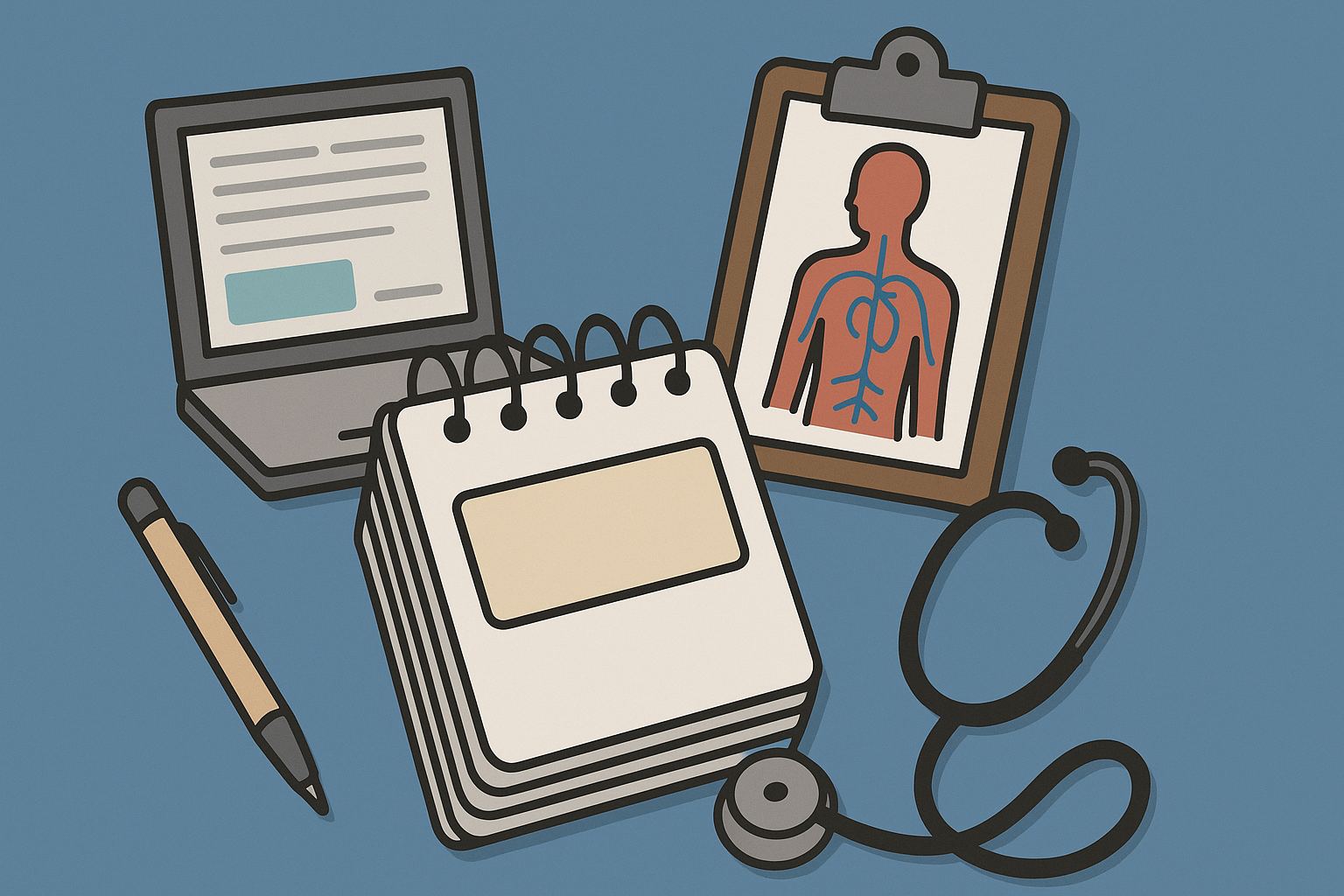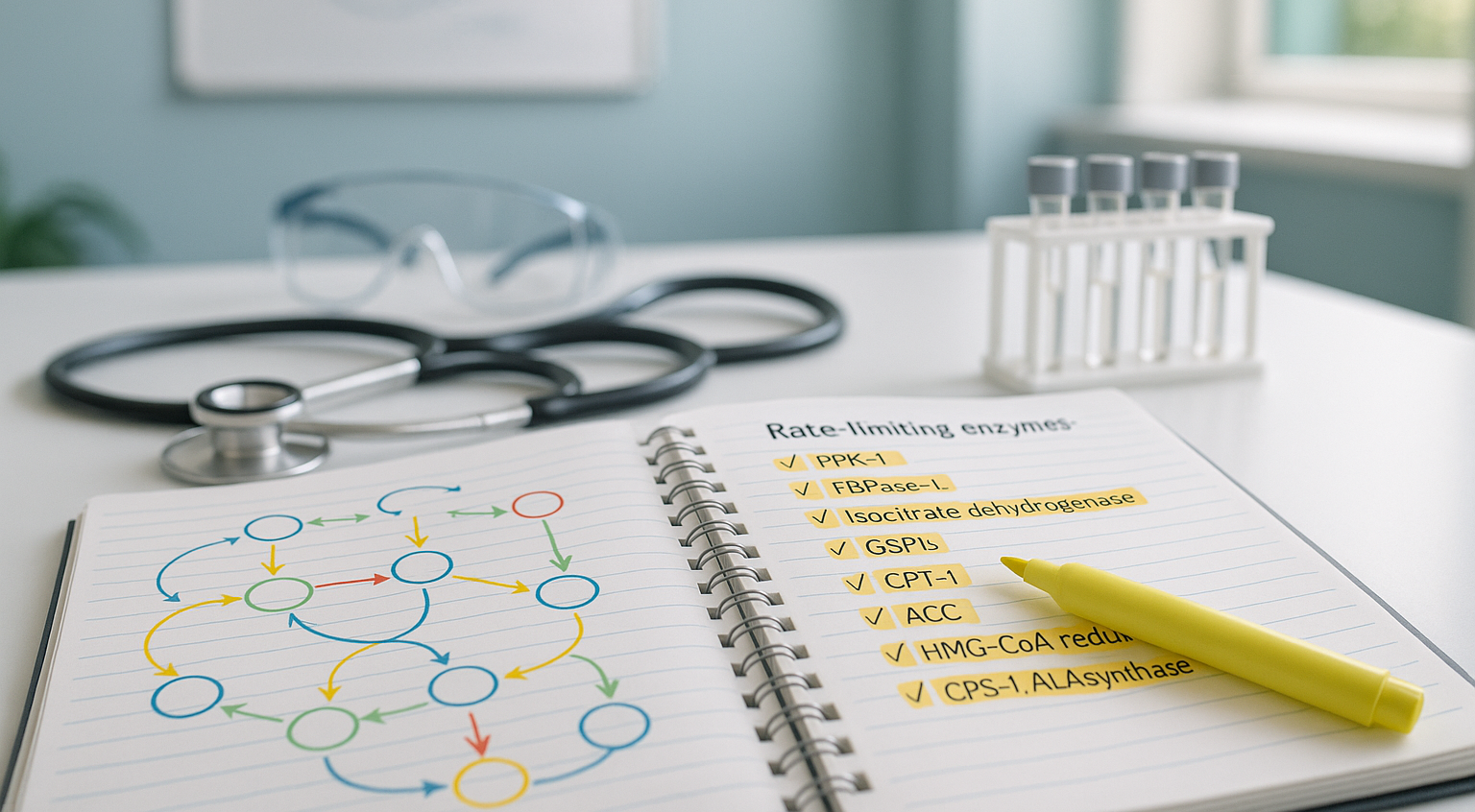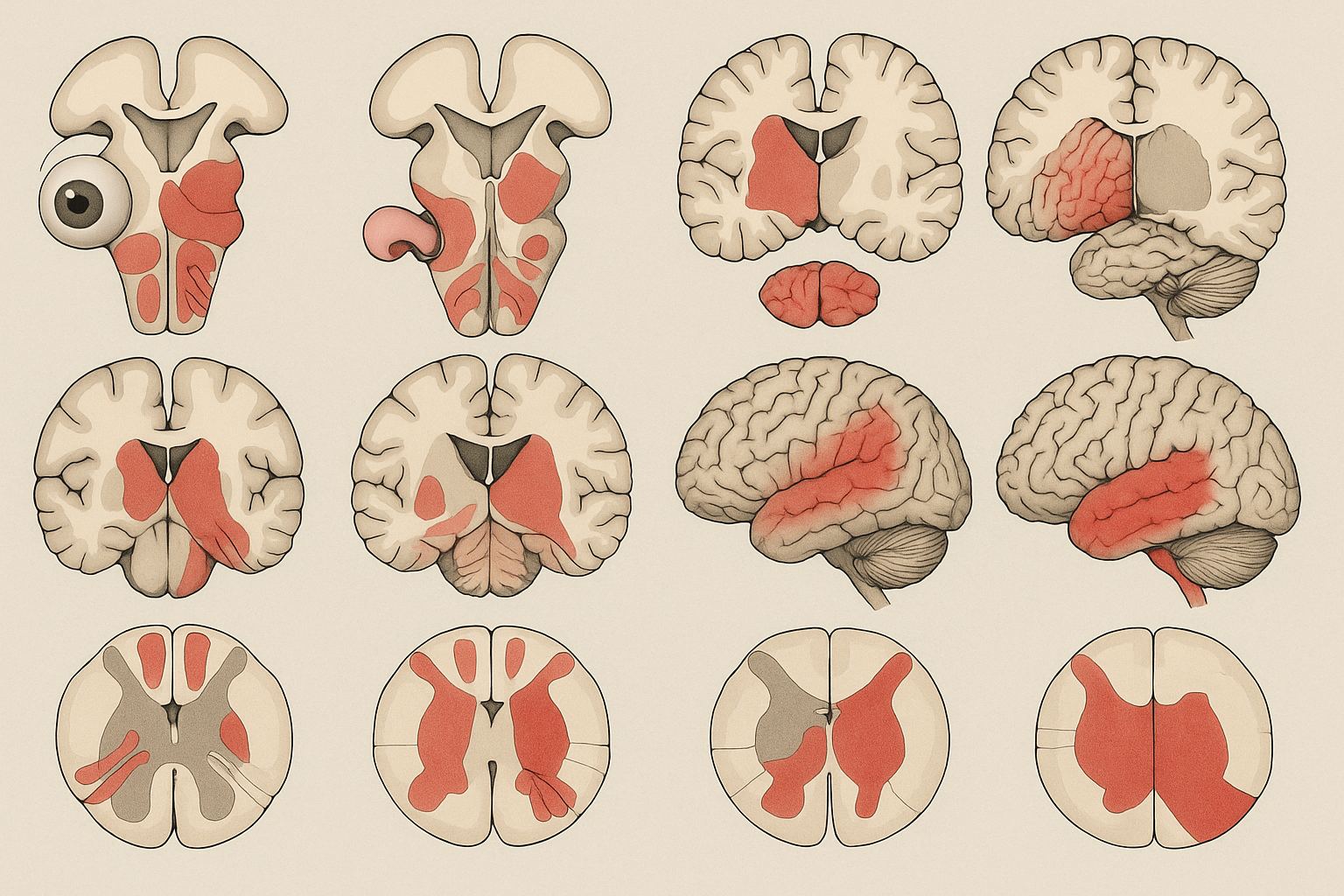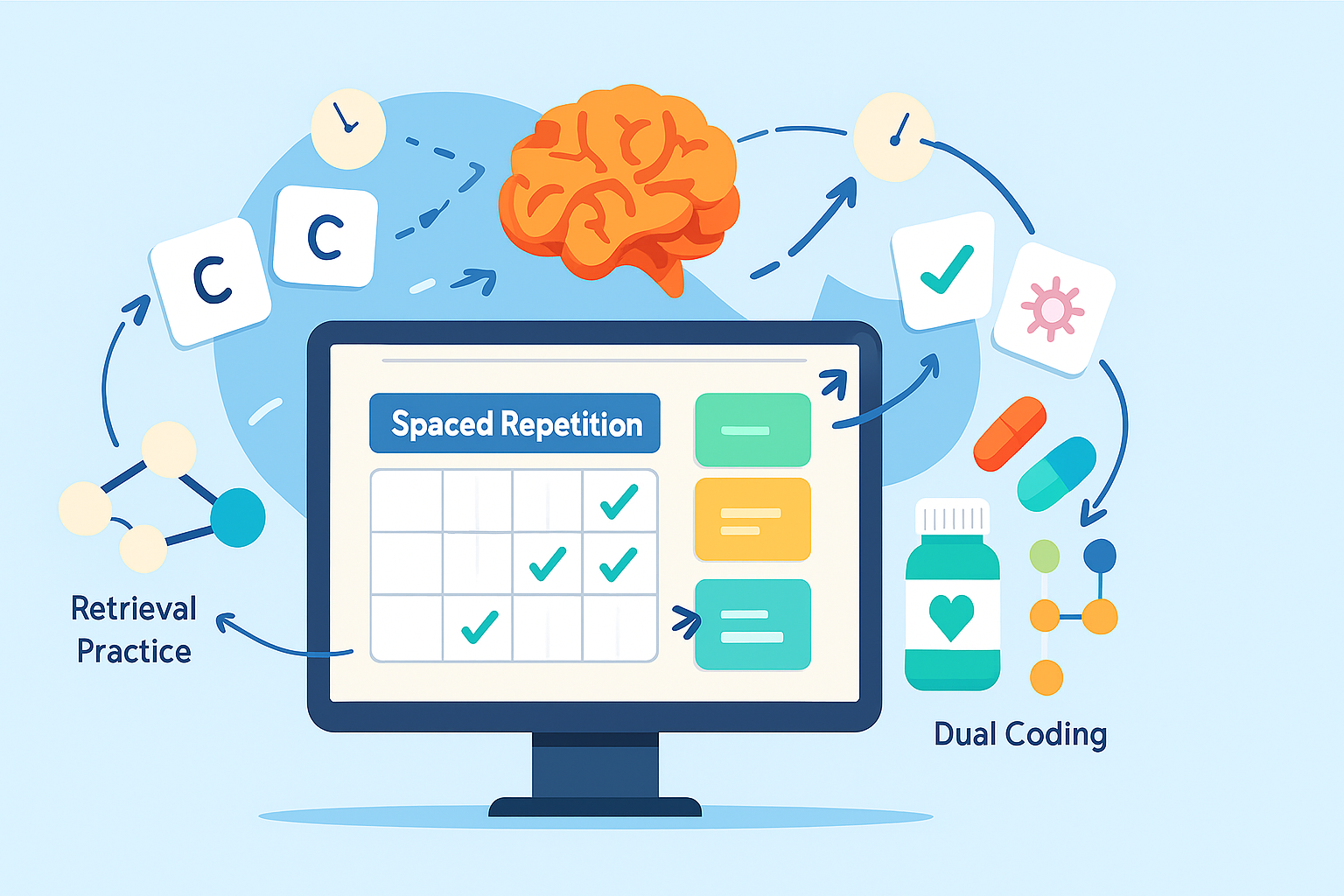A repeatable micro-flow to cut rereads, pre-commit your retrieval path, and neutralize distractors in NBME-style items.
Use this on every question: Lead-In → Prediction → Skim → Verify. Read the task first, form a mechanism-level hypothesis, then skim the stem for confirming/contradicting cues before you check the choices. This preserves working memory, reduces anchoring errors, and accelerates elimination.
Why “Lead-In First” Works Under Step 1 Time Pressure
Step 1 items are designed to test mechanism-level reasoning while exploiting cognitive limits. Long stems, near-miss distractors, and mixed-relevance details inflate intrinsic and extraneous load. The practical consequence is rereading, attention drift, and late-block rushing. The “Lead-In First” method counteracts this by forcing you to define the task before consuming the stem. Knowing whether you’re being asked for a mechanism, expected change, most specific finding, or the effect of a mutation/drug focuses attention on the few cues that truly matter and permits rapid elimination of off-task details.
This approach mirrors how experienced test-takers naturally operate: they anchor on the question’s verb and object (“Which of the following best explains…”, “What change is most likely…”) and run a quick, internal search for candidate mechanisms before allocating reading time. It also limits confirmation bias by encouraging an explicit, lightweight prediction you will actively try to disconfirm while skimming. If the stem contradicts your first hypothesis, you pivot early rather than doubling down.
Crucially, the method respects Step 1’s emphasis on integration. A prediction framed as a mechanism one-liner (e.g., “Noncompetitive antagonist ↓Emax, no shift in EC50”) primes you to recognize the correct relationship even when the item is dressed in unfamiliar clinical veneer. Because you are not yet staring at answer choices, you’re less vulnerable to attractive nuisances (e.g., a plausible clinical diagnosis when the task is actually to name the receptor change).
Finally, the time economics are favorable: investing ~10 seconds to extract the task and frame a hypothesis typically saves 20–40 seconds of unfocused stem re-reads and post-choice backtracking. Across a 40-question block, that margin is the difference between finishing with a 3–5-minute review buffer versus guessing through the final five items. The remainder of this guide operationalizes the micro-flow, shows what to read and what to ignore, and provides drills to make the sequence automatic.
The Four-Step Micro-Flow: Lead-In → Prediction → Skim → Verify
1) Lead-In. Look at the final question sentence first. Extract the task verb (ask type), the target concept (mechanism, pathway node, parameter), and any constraints (“most specific”, “earliest change”, “lab value expected”). Spend ≤10 seconds. Do not peek at choices yet—choices bias attention and inflate extraneous load.
2) Prediction. Generate a terse, mechanism-level one-liner that could answer the question. This is not a lock; it’s a compass. Examples: “↑cAMP via Gs”, “AR mutation → frameshift/truncation → loss of function”, “Noncompetitive antagonist ↓Emax unchanged EC50”, “Obstructive lung disease: ↑RV, ↑FRC, ↓FEV1/FVC.” The prediction constrains what evidence you seek in the stem and speeds elimination later.
3) Skim (purposeful). Read the stem once with intent. Harvest only the cues that test the predicted mechanism: age/sex, key exposures (drugs, toxins), time course (acute vs chronic), sentinel labs/graphs (direction & relationship, not raw numbers), and any red-flag contradictions. Ignore decorative history, redundant vitals, and distractor-bait adjectives unless they directly adjudicate your prediction. If the stem breaks your hypothesis, pause and re-predict before reading choices.
4) Verify with choices. Now open the choices. Attempt rapid two-turn elimination: first, discard options incompatible with the task verb (e.g., a diagnosis when asked for a receptor change). Second, eliminate options inconsistent with the directional relationships you extracted (e.g., choices that shift EC50 when the correct mechanism alters Emax). Only then pick among survivors. If two remain, prefer the option that best matches the constraint (earliest, most specific, rate-limiting).
Guardrails. If >60 seconds elapse without traction, mark/guess using the best surviving mechanism and move on. The micro-flow is designed to maximize the number of easy-to-moderate wins per block; do not let an outlier item cannibalize your buffer.
Lead-In First — Micro-Flow (Step 1)
Follow in order: Lead-In → Prediction → Skim → Verify & Choose. If the stem contradicts your prediction, loop back to Re-Predict, then proceed.
1
Lead-In
- Underline verb + object + constraint.
- Ignore answer choices (for now).
- Spend ≤10 seconds.
2
Prediction
- State a mechanism one-liner.
- Examples: “↓Emax no ΔEC50 = noncompetitive”.
- Treat it as a hypothesis, not a lock.
3
Skim (Purposeful)
- Harvest only cues that confirm/contradict.
- Age/sex, exposure, time course, key labs/graphs.
- If contradicted → Re-Predict.
4
Verify & Choose
- Turn-1: kill task mismatches.
- Turn-2: kill wrong direction/parameter.
- Soft cap ~80–90 s → mark/guess/move.
From Skim → Decision
Contradiction
detected?
Yes
Re-Predict
Restate one-liner → Re-skim
No
Proceed to Verify
Two-turn elimination
Arrows: sequence
Yes loop back
No continue forward
Extract the Task in ≤10 Seconds: What to Read, What to Ignore
The lead-in encodes the cognitive operation Step 1 wants. Train your eye to capture three elements instantly: (1) the verb (identify, predict, calculate, explain), (2) the object (enzyme, receptor, physiologic parameter, mutation effect), and (3) the constraint (most likely, earliest, best indicator, direction of change). This triad dictates what to harvest from the stem and narrows your internal search space before choices exert anchoring pressure.
| Lead-In Verb | What You’re Being Tested On | What to Harvest from Stem | Common Off-Task Traps |
| Predict the change in X | Directional physiology/biochem relationship | Trend, relative direction, upstream vs downstream node | Absolute numbers; unrelated comorbidities |
| Identify the mechanism | Pathway linkage, receptor class, enzyme step | Exposure, time course, key trigger (drug/toxin) | Final diagnosis; imaging minutiae |
| Which mutation is most likely? | Genetic consequence → functional effect | Inheritance pattern, protein domain affected | Phenotypic ornamentation |
| Which graph is consistent? | Parameter relationships (Emax/EC50, preload/afterload) | Axes labels, curve shifts, comparative positions | Y-axis scale fixation; curve color |
Rapid extraction drill. Take 10 retired items, hide the stems, and list only lead-ins. For each, write the task triad and a one-line mechanism prediction. Then reveal the stem and test whether your skim would have targeted the right cues. The aim is not perfect prediction; it is reliable narrowing so that your first read is selective rather than exhaustive.
What to ignore on first pass. Names, hobbies, redundant normal vitals, and anecdotal color often exist to simulate realism. If a detail neither confirms nor contradicts your predicted mechanism, let it go. You can revisit if verification with choices fails.
Master your USMLE prep with MDSteps.
Practice exactly how you’ll be tested—adaptive QBank, live CCS, and clarity from your data.
What you get
- Adaptive QBank with rationales that teach
- CCS cases with live vitals & scoring
- Progress dashboard with readiness signals
No Subscriptions • No Credit Card to Start
Create your account
Build Prediction Habits with Mechanism One-Liners
Predictions work when they are compact, mechanistic, and generalizable across organ systems. The goal is a mental library of one-liners that translate cues into answer-shaping expectations. These differ from mnemonics; they are causal statements that forecast the correct relationship or directional change regardless of surface context.
- Pharm dynamics: “Noncompetitive antagonist ↓Emax; competitive antagonist ↑EC50 without changing Emax.”
- Autonomics: “M3 agonism → ↑glandular secretion, ↑smooth muscle contraction (bronchospasm, miosis).”
- Biochem regulation: “Allosteric inhibitor binds regulatory site → ↓Vmax, no change Km for non-competitive; competitive ↑Km, Vmax unchanged.”
- Respiratory: “Obstruction → ↑RV & FRC, ↓FEV1/FVC; Restriction → ↓all lung volumes, FEV1/FVC normal or ↑.”
- Genetics: “Frameshift early in coding region → truncated nonfunctional protein (loss of function).”
Habit loop. (1) Lead-in triad. (2) State one one-liner matching the task. (3) Skim to collect only the variables that could falsify it. (4) Verify or pivot. This loop prevents wandering stems and protects against being seduced by a plausible diagnosis when the item wants a signal pathway or graph shift.
Practice structure. Build a personal “mechanism atlas.” For each major Step 1 domain—biochem, physio, pharmacology, immunology, micro—write 10–15 one-liners with a minimal example. During blocks, annotate misses by adding or correcting one-liners (e.g., “AR partial agonist: ↓Emax vs full agonist; apparent ↓potency for endogenous agonist”). Over time the atlas becomes your fastest elimination tool because it predicts which choices cannot be true before you see them.
Quality control. A good one-liner is specific enough to rule things out but abstract enough to transfer across contexts. “Beta-blockers reduce heart rate” is too coarse; “β1 antagonism → ↓cAMP in nodal cells → ↓If and Ca2+ currents → ↓HR and AV conduction” constrains graphs and choice phrasing you will accept.
Neutralize Distractors: Archetypes and Two-Turn Elimination
Step 1 distractors are rarely random; most follow predictable archetypes. Learning to name the trap shortens the path to elimination. Combine this with a two-turn elimination (task-mismatch first, mechanism-mismatch second) to collapse choices quickly.
| Distractor Archetype | Signature | Fast Counter | Example (Condensed) |
| Task Mismatch | Looks like a diagnosis/therapy when asked for mechanism/parameter | Eliminate on Turn-1 if verb/object mismatch | “Acute interstitial nephritis” when lead-in asks “Which transporter is upregulated?” |
| Direction Trap | Correct concept, wrong sign/axis/shift | Cross-check your one-liner’s direction | Competitive antagonist option showing ↓Emax |
| Prototype Lure | Iconic but off-pathway fact | Ask “Does this explain this verb?” | “p53 tumor suppression” when asked about Rb phosphorylation state |
| Magnitude Bait | Absolute numbers vs relative change | Re-read constraint: earliest/most specific/most likely | Picking “largest increase” when item asks “earliest measurable change” |
| Timeframe Error | Chronic effect offered in an acute scenario | Bind to time course in stem | Upregulation statement in minutes-to-hours setting |
Two-turn elimination. Turn-1: Sweep for task mismatches—anything that fails the verb/object test dies immediately. Turn-2: Among survivors, apply your prediction one-liner to kill directionally inconsistent options. This sequence is faster than reading all five choices with equal intensity and postpones costly comparative reasoning until the field is small.
When two remain. Use the constraint as a tiebreaker. “Most specific” favors findings with high specificity even if sensitivity is lower; “earliest” favors upstream events (e.g., transcription factor activation before protein accumulation). If still tied, choose the option that explains more of the stem with less assumption.
Timing Architecture for 40-Question Blocks (Two-Pass Integration)
“Lead-In First” slots neatly into a two-pass timing system that protects your end-of-block buffer. The aim is to finish Pass-1 with all easy-to-moderate items answered and 5–7 minutes banked for triage.
| Phase | Per-Item Target | What You Do | Skip/Flag Rule |
| Lead-In | ≤10 s | Verb + object + constraint | None |
| Prediction | ~5–10 s | Mechanism one-liner | None |
| Skim | ~25–35 s | Harvest only mechanism-relevant cues | Re-predict if contradicted |
| Verify + Choose | ~15–25 s | Two-turn elimination | If unresolved at ~75–90 s: mark/guess/move |
Block-level pacing. Start with a conservative 75–80 seconds soft cap per item on Pass-1 (average requirement ≈ 90 seconds). This forces momentum and prevents early sunk-cost spirals. Use the test interface’s “mark” feature aggressively for any item that resists the micro-flow. On Pass-2, revisit flagged items with fresh eyes; many resolve within 20–30 seconds once working memory is reset.
Final triage (5 minutes). Sort remaining flags by expected value: (1) two-option coin flips with clear mechanisms get priority, (2) computation-heavy or novel pathways come last. When time expires mid-reasoning, pick the option most consistent with the lead-in constraint and your best surviving one-liner.
Common pacing errors. Reading choices before forming a prediction; rereading full stems within the first 60 seconds; refusing to guess when stuck; and spending disproportionate time on visually dense items (graphs/micrographs) without running the same micro-flow. The method is universal—apply it to figures by treating axes/labels as the “lead-in” for the visual.
Rapid-Review Checklist and On-Exam Templates
Use this compact checklist during practice to engrain the sequence until it is automatic under pressure. Print it or rewrite it on your scratch sheet at the start of a block.
Lead-In First — 10-Second Drill
- Underline the verb and object; circle any constraint.
- Say a one-liner prediction (mechanism/relationship).
- Skim for confirm/contradict cues only.
- Open choices → Turn-1: task mismatch kill → Turn-2: direction mismatch kill.
- Soft cap ~80–90 s → mark/guess/move if unresolved.
Figure/Graph Mini-Template
- Axes & units → what is measured?
- Baseline vs intervention curves → shift or max?
- Outlier/inflection → rate-limiting or saturation?
- Map to one-liner (e.g., competitive vs noncompetitive).
- Eliminate by wrong direction or parameter.
Exam-Day Essentials (Pocket List).
- Before each item: “What are they asking me to do?” (verb, object, constraint).
- Say it out loud in your head: one-liner prediction.
- Skim once: harvest only task-relevant cues; ignore décor.
- Choices last: Turn-1 task mismatch, Turn-2 mechanism/direction mismatch.
- Time guard: at ~90 seconds without traction, mark → best guess → move.
- Between blocks: jot 1–2 new one-liners learned; retire a bad habit you noticed.
Keep this list brutally short. The goal is a frictionless ritual that runs in the background while your attention addresses mechanism and relationships—not a new cognitive burden.
Drills, Metrics, and Debrief: Converting Technique into Points
Drills. (1) Lead-ins only: Compile 20 lead-ins from a Q-bank. For each, write the task triad and a one-liner. Flip the stem and check if your skim would target the right variables. (2) One-liner sprints: Pick a system (e.g., renal). In 5 minutes, generate as many high-yield one-liners as possible (physio relationships, enzyme regulations, curve shifts). (3) Two-turn elimination reps: For 10 items, force yourself to verbalize the Turn-1 kill phrase (“Task mismatch”) and Turn-2 kill phrase (“Wrong direction/parameter”) before selecting.
Metrics. Track: (a) average decision time on first-pass corrects (aim <70–80 s), (b) proportion of items where you read choices before forming a prediction (drive toward 0), (c) number of early pivots after contradiction detected (healthy sign of flexibility), and (d) end-of-block buffer minutes (target 3–7 minutes). Review flagged items to see if the stall point was failure to extract the task, an inadequate one-liner, or an unrecognized distractor archetype.
Debrief structure (10–12 minutes after each block). For each miss or guess, answer: (1) Did I define the task (verb/object/constraint) first? If not, rewrite the lead-in in your words. (2) What was my one-liner? If none, write one now. (3) Which detail in the stem should have falsified my first hypothesis earlier? (4) Which distractor archetype fooled me? (5) What micro-adjustment will I apply next block (e.g., “When the verb is ‘earliest,’ I will explicitly mark upstream events on my scratch space”). Capture these in a running “Technique Log.”
Long-run integration. As content mastery grows, the micro-flow gets faster because predictions become richer. Continue curating the mechanism atlas and, weekly, convert it into 10 fresh flash-style retrieval prompts that mirror lead-ins (“Earliest change after β-blocker?” “Graph after noncompetitive antagonism?”). This keeps retrieval fluent and aligned with the exact tasks Step 1 demands.
References & Further Reading
- USMLE Step 1 Content Outline & Specifications
- NBME Examinee Guide (Exam Interface & Block Structure)
- Dunlosky J, et al. Improving Students’ Learning with Effective Learning Techniques. Psychological Science in the Public Interest (2013). Link
- Roediger HL, Karpicke JD. Test-Enhanced Learning. Psychological Science (2006). Link
- Sweller J. Cognitive Load Theory. Psychology of Learning and Motivation (2011). Link
- Tversky A, Kahneman D. Judgment under Uncertainty: Heuristics and Biases. Science (1974). Link
- Cepeda NJ, et al. Distributed Practice in Verbal Recall Tasks: A Review and Quantitative Synthesis. Psychonomic Bulletin & Review (2006). Link
100+ new students last month.






